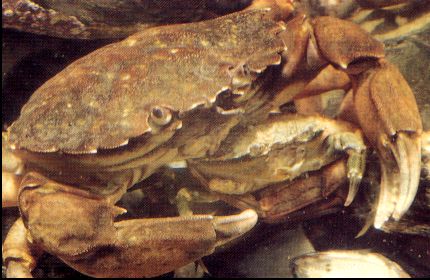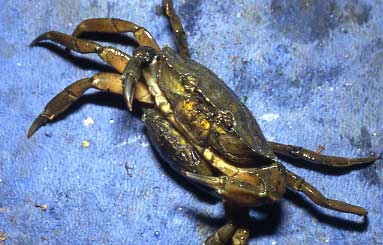
|
|
| Porifera |
| Ctenophora |
| Cnidaria |
| Mollusca |
| Annelida |
| Arthropoda |
| Other Phyla |
| Chordata |
| ARTHROPODA |
| Uniramia (Insecta) |
| Chelicerata |
| Crustacea |
| Pycnogonida |
| CRUSTACEA |
| Branchiopoda |
| Branchiura |
| Cirripedia |
| Copepoda |
| Ostracoda |
| Malacostraca |
| MALACOSTRACA |
| Stomatopoda |
| Mysidacea |
| Cumacea |
| Isopoda |
| Amphipoda |
| Euphausiacea |
| Decapoda |
| DECAPODA |
| Caridae |
| Astacidae |
| Palinura |
| Anomura |
| Brachyura |
|
|
Shore Crab
 |
Common
Name(s):
Shore Crab European Green Crab, Applejacks (Newhaven, Sussex), Addlers (Shoreham, Sussex) Scientific Name: Carcinus maenas Family: Portunidae Subfamily: Carcininae Usual Size: to 6 cm (length of carapace) width to about 10 cm up to 149 grams (see note) |
| Identification:
Photographs:  Colour: Brown. Some specimens about 5% of adults are green. Juveniles in a mixture of colours. Similar species: Velvet Swimming Crab, Necora puber.

Shore
Crabs,
Carcinus
maenas
Male Shore Crab The
large flap (broader abdomen) of the female crab used to hold the eggs
Habitat:
Bionomics:
Additional
Notes:
5 November
2009
20
June 2005
Report
by Derek Neate (FOWL)
With the
low level (0.27 metres) of the lagoon, the patch of water by the inlet
pipe became isolated from the main body of water. In this puddle the salinity
was recorded at a hypersaline 42.8‰ after two weeks of warm weather (air
temperatures over 24° C and over 27° C) and a water temperature
of 30.2° C. The main body of the lagoon registered a salinity of 37‰.
(The conditions were favourable for evaporation.)
Readings
by John Knight (WSCC)
These
two events are probably connected. In June (in Sussex) the Shore
Crab moves in estuaries and into lower salinity
water than the sea. In water temperatures of over 28°
C or with a salinity over and above natural
seawater at about 34.5‰
this
crab has been known to leave the water and perish if it is unable to find
a favourable niche. (The conditions are outside its natural amplitude for
survival.)
2002
and earlier
16
July 1999
Report
by Chris Everson
Katherine Hamblett at Adur World Oceans Day 2000 The
female Shore Crab in the picture called "Sandy"
weighed 78.81 grams alive on 20 June 2000. The carapace measured 70.61
mm wide. (Imperial 2.78 oz, 2.78 in.). It died about a year later without
moulting.
Each year in the delightful coastal village of Walberswick in Suffolk, The British Open Crabbing Championship is held. The heaviest crab known was the winner of the Walberswick Crabbing competition in 1981 which weighed in at 7.25 oz (205.5 grams). Crabs of over 3 oz are caught every year, crabs of over 4 oz are prize winners and crabs of 5.25 oz have been caught. The second heaviest Walberswick Shore Crab was caught on 6 August 2000 and weighed nearly 7 oz. Message-Id:
<v0422080bb647c7b02dcd@[130.241.158.139]>
Thank you to all who responded regarding the maximum size in Carcinus maenas. I have not yet received any reply that confirms that a Carcinus larger than 100 mm CW has been collected. Greg
Jensen from University of Washington reported
that Carcinus close to 100 mm CW have been caught in Bodega Harbor,
California (the largest confirmed was 96 mm). Wim Vader from Tromsø
Museum in Norway believe
Carcinus grow larger than 100 mm in northern
Norway, but it has not been possible to confirm this yet. I also
heard some rumors
A quick look through the literature produced the following list of unusually large Carcinus: Location Reference Max CW Denmark
(Munch-Petersen 1982): 75 mm
Thus, the 100 mm CW beast caught in Sweden last month appear to be the largest reported Carcinus maenas. Per-Olav
Moksnes, Ph.D.
Maximum
quoted size
= 86 mm carapace breadth [which doesn't sound very big
Field Studies Council Publications The Field Studies Council publish a special booklet on the Shore Crab. They also publish an excellent guide called "A Key to the Crabs and Crab-like Animals of British Inshore Waters" by John & Marilyn Crothers. ISBN 1 85153 155 5 "The Biology
of the Shore Crab Carcinus maenas (L)" by J.H.Crothers
From:
Field
Studies Council, Preston Montford, Shrewsbury SY4 1HW
Information wanted: Please
send any unusual records of this crab, with location, date, who discovered
it, how it was identified, prevalence, size, whether 'in berry', common
name and any other details to
|
| FIVE KINGDOMS TAXONOMIC INDEX TO BRITISH MARINE WILDLIFE |
|
|
|
|
|
News 2018 |
Membership Form |
|







